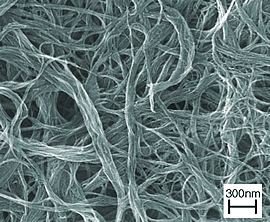|
Super Capacitor Batteries |
|
|
..
Nanotechnology Shows Promise
in Quest for Improved Power Storage Devices
Car batteries as we know them today may soon be relics. Storing energy in clunky containers with limited shelf lives has plagued car makers and military engineers who need lightweight, powerful and reliable means to crank engines into life, enliven radios and operate other electronic appliances. But research by post-doctoral Researcher Jiyoung Oh and Research Scientist Mikhail “Mike” Kozlov at UT Dallas’ NanoTech Institute offers tantalizing insights into a new, lightweight, reliable means of delivering power via the mighty supercapacitor. A photograph of a material obtained in their research made the cover of the journal Synthetic Metals along with the published paper, (Synthetic Metals, 158 (2008) 638). “We were extremely proud to see the scanning electron micrograph of our carbon nanotube sheet on the cover of this research journal,” Kozlov said. “The focus of this journal is on important accomplishments in the field of conductive polymers and molecular electronics.” Supercapacitors are beefed-up electronic components that can be charged and counted on to store energy reliably for long periods. They deliver power in a smooth, steady stream safe for operating sensitive electronics. Unlike car lead batteries, which are typically heavier and bulkier, capacitors and super-capacitors accumulate electric charge instead of delivering it via a chemical reaction. Being lightweight, reliable, safe and efficient while also offering a steady stream of power is a prized set of attributes that technology designers readily seek out. But how do they bridge the gap between current designs that call for batteries and the virtually limitless design possibilities offered when supercapacitors offer up power and the battery box disappears? That’s where Drs. Oh and Kozlov step in. The team, along with legendary nanotechnology pioneer Dr. Ray Baughman, developed a means to create supercapacitors using “paper” sheets of single-walled carbon nanotubes embedded with a special polymer called polypyrrole. Imagine if the boxy, heavy car battery morphed into something light, strong, perhaps paper-thin and flexible that could be molded to fit elsewhere in the vehicle—even hidden in plain sight. Getting rid of the weight and bulk of batteries could prove especially helpful in hybrid car designs, which today rely on a suitcase-sized array of hefty, metal batteries. And that’s just one application. “Our electrode preparation procedure is an extension of conventional bucky-paper [a film made of 100 percent carbon nanotubes] fabrication technique for the multi-component system,” Oh said. “This procedure is easily scalable for device fabrication on an industrial scale.” This team’s research was supported in part by the International Research Internship Program of the Korea Research Foundation, a Korea Research Foundation Grant, a Robert A. Welch Foundation grant and funds from the LINTEC Corporation—a firm that collaborates with UT Dallas’ NanoTech Institute on supercapacitor research. Media Contacts: Brandon V. Webb, UT Dallas, (972) 883-2155,
Brandon.webb@utdallas.edu
SOURCE: University of Texas |
|
| Method and Apparatus for Large
Scale Storage of Electrical Potential
US Patent 7,251,118 A new patent has been developed that provides a solution to one of the main inconveniences with current energy storage. The proposed solution involves the use of a special class of capacitors, called supercapacitors, which have the potential to store large quantities of energy in a small volume. Electricity is difficult to store which can cause energy generation inefficiencies. This often results in situations where the supply of electricity does not meet the demand. Current energy storage solutions do not eliminate the disparity between supply and demand. This can be seen, for example, by considering the harvesting of solar energy in Southern California. In such a situation, peak energy input occurs close to 2PM but maximum demand for power does not occur until 5PM. Storing the energy for these three hours is very difficult. Conventional storage methods, such as batteries, pumped storage, and flywheels, are insufficient and can waste up to 70% of the stored energy. Power plants experience similar efficiency problems. All power plants, whether they uses coal, oil, or gas, achieve maximum efficiency when they are operated at constant output. These plants, however, are designed to accept the maximum load. By developing an effective way to store the output, less fuel would be burned and the amount of copper used in transmission lines could be reduced. A solution to this energy storage problem may lie in the development of the supercapacitors described in this patent. These devices have the potential to store large amounts of energy in a small volume. The technology proposed in this patent allows for large amounts of electricity to be stored on non-planar conformal plates. These nonplanar nanostructures would result in significantly higher energy storage densities than existing methods. For more information on this cutting edge technology
and U.S. Patent
7,251,118
SOURCE: Nonplanar-Nanostructures |
|
Related Links:
|
|
| FAIR USE NOTICE: This page contains copyrighted material the use of which has not been specifically authorized by the copyright owner. Pegasus Research Consortium distributes this material without profit to those who have expressed a prior interest in receiving the included information for research and educational purposes. We believe this constitutes a fair use of any such copyrighted material as provided for in 17 U.S.C § 107. If you wish to use copyrighted material from this site for purposes of your own that go beyond fair use, you must obtain permission from the copyright owner. | |
|
|

